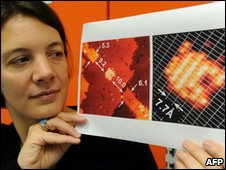 With Processor fabrication getting better and better every year at the pace of Moore’s law, a new research will Leap frog the innovation.
With Processor fabrication getting better and better every year at the pace of Moore’s law, a new research will Leap frog the innovation.
Moore’s Law predicts that the amount of memory that can fit on a given area of silicon, for a fixed cost doubles every 12-18 months. The limit of this prediction is being tested as components get ever smaller and their computationally useful properties become less reliable.
Researchers have managed to create a transistor made from just seven atoms. When such technology is used to design computers, the processor would be 1/100th of the size it is today, making it possible to package more transistors on a single chip, and hence increasing the power of computing by several times. The scientists believe that it is also a step towards a solid-state quantum computer.
Basically, Transistors acts as a tiny switch which becomes the building block of all silicon chips. However, this transistor is not the smallest ever created as two research groups have previously managed to produce working single-atom transistors, but the latter was never demonstrated to work as effectively as the current one.
The paper is entitled “Spectroscopy of Few-Electron Single-Crystal Silicon Quantum Dots“.
“We are manipulating individual atoms and placing them with atomic precision, in order to make a working electronic device,” elaborated Simmons. “We have replaced just seven individual silicon atoms with phosphorus atoms. That is amazing exactness”.
Modern Chips where components are 22 nanometres in size, transistor gates are about 42 atoms wide. The working transistor was created by replacing seven atoms in a silicon crystal with phosphorus atoms.
This is the world’s first electronic device in silicon systematically created on the scale of individual atoms as per Professor Michelle Simmons, lead researcher on the project at the University of New South Wales.
If an entire chip could be made with every one of its billions of transistors made from the silicon crystals, it could mean an “exponential” leap in processing power.
When?
There’s a long way before these chips commercialize, The current tiny transistor they created was handmade using a scanning tunnelling microscope to move the phosphorus atoms into place.
Although it was first developed in 1981, it uses extremely challenging techniques that require highly clean and stable surfaces, exceptional vibration control, and sophisticated electronics. Simmons’ team is now applying those techniques towards their first quantum computer.
Quantum computing is expected to be the next big scientific leap, and could revolutionize cryptography, weather forecasting, and nuclear modeling amongst other fields.
For latest Open Source, iPhone, Android, Hardware, Tech news @taranfx on Twitter or subscribe below:
loading...
loading...

Awesome.
loading...
loading...
that is just amazing how there is no end to this
loading...
loading...